Samsung SM-G532F, SM-G532G User Guide

SM-G532F
SM-G532F/DS
SM-G532G/DS
User Manual
English. 10/2016. Rev.1.0 |
www.samsung.com |
Table of Contents
Basics |
Applications |
||
4 |
Read me first |
45 |
Installing or uninstalling apps |
5 |
Package contents |
47 |
Phone |
6 |
Device layout |
51 |
Contacts |
8 |
Battery |
54 |
Messages |
13 |
SIM or USIM card |
57 |
Internet |
17 |
Memory card (microSD card) |
59 |
|
18 |
Turning the device on and off |
60 |
Camera |
19 |
Touchscreen |
69 |
Gallery |
21 |
Home screen |
73 |
Samsung Notes |
27 |
Lock screen |
75 |
Calendar |
28 |
Notification panel |
77 |
Voice Recorder |
31 |
Entering text |
77 |
My Files |
33 |
Screen capture |
78 |
Clock |
33 |
Opening apps |
79 |
Calculator |
34 |
Secure Folder |
80 |
Radio |
37 |
Samsung account |
81 |
Google apps |
39Transferring data from your previous device
41 Device and data management
43Sharing features
44Emergency mode
2

Table of Contents
Settings
83 Introduction
83 Connections
92Sounds and vibration
93Notifications
93Display
94Wallpapers
95Advanced features
97Device maintenance
99Applications
99Lock screen and security
100Cloud and accounts
102Google
102Accessibility
102General management
103Software update
103User manual
103About device
Appendix
104 Troubleshooting
3
Basics
Read me first
Please read this manual before using the device to ensure safe and proper use.
•Descriptions are based on the device’s default settings.
•Some content may differ from your device depending on the region, service provider, model specifications, or device’s software.
•Content (high quality content) that requires high CPU and RAM usage will affect the overall performance of the device. Apps related to the content may not work properly depending on the device’s specifications and the environment that it is used in.
•Samsung is not liable for performance issues caused by apps supplied by providers other than Samsung.
•Samsung is not liable for performance issues or incompatibilities caused by edited registry settings or modified operating system software. Attempting to customise the operating system may cause the device or apps to work improperly.
•Software, sound sources, wallpapers, images, and other media provided with this device are licensed for limited use. Extracting and using these materials for commercial or other purposes is an infringement of copyright laws. Users are entirely responsible for illegal use of media.
•You may incur additional charges for data services, such as messaging, uploading and downloading, auto-syncing, or using location services depending on your data plan. For large data transfers, it is recommended to use the Wi-Fi feature.
•Default apps that come with the device are subject to updates and may no longer be supported without prior notice. If you have questions about an app provided with the device, contact a Samsung Service Centre. For user-installed apps, contact service providers.
•Modifying the device’s operating system or installing softwares from unofficial sources may result in device malfunctions and data corruption or loss. These actions are violations of your Samsung licence agreement and will void your warranty.
•Depending on the region, you can view the regulatory information on the device. To view the information, tap Apps →Settings →About device →Regulatory information.
4

Basics
Instructional icons
Warning: situations that could cause injury to yourself or others
Caution: situations that could cause damage to your device or other equipment
Notice: notes, usage tips, or additional information
Package contents
Check the product box for the following items:
•Device
•Battery
•Quick start guide
• The items supplied with the device and any available accessories may vary depending on the region or service provider.
•The supplied items are designed only for this device and may not be compatible with other devices.
•Appearances and specifications are subject to change without prior notice.
•You can purchase additional accessories from your local Samsung retailer. Make sure they are compatible with the device before purchase.
•Use only Samsung-approved accessories. Using unapproved accessories may cause the performance problems and malfunctions that are not covered by the warranty.
•Availability of all accessories is subject to change depending entirely on manufacturing companies. For more information about available accessories, refer to the Samsung website.
5
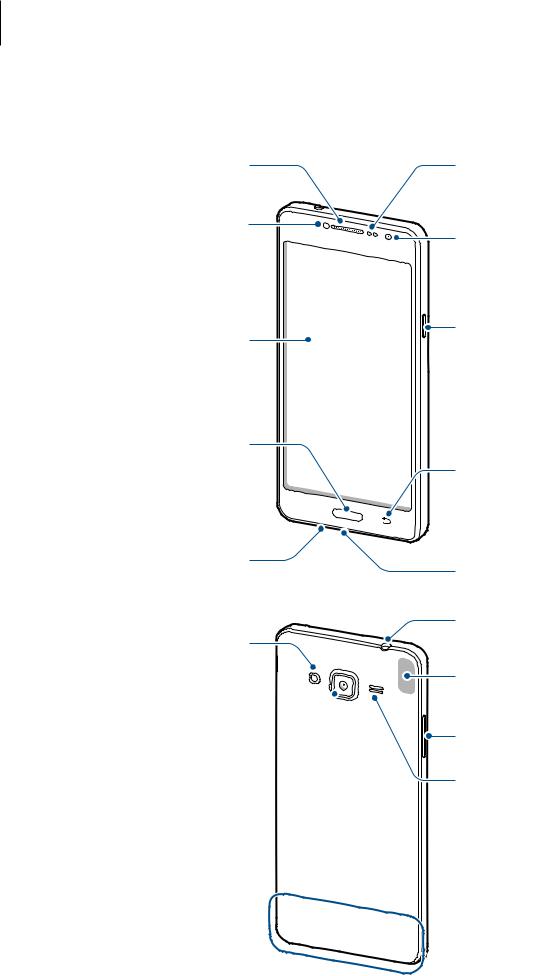
Basics
Device layout
Receiver |
Proximity sensor |
Flash |
Front camera |
|
Touchscreen |
Power key |
|
Home key
Back key
Recents key 

Microphone
Multipurpose jack
Headset jack
Flash
GPS antenna
Rear camera
Volume key
Speaker
Back cover 
Main antenna 
6

Basics
• Connectivity problems and battery drain may occur in the following situations:
– –If you attach metallic stickers on the antenna area of the device
––If you attach a device cover made with metallic material to the device
––If you cover the device’s antenna area with your hands or other objects while using certain features, such as calls or the mobile data connection
•Using a Samsung-approved screen protector is recommended. Unapproved screen protectors may cause the sensors to malfunction.
•Do not allow water to contact the touchscreen. The touchscreen may malfunction in humid conditions or when exposed to water.
Keys
Key |
Function |
||
Power |
• |
Press and hold to turn the device on or off. |
|
• |
Press to turn on or lock the screen. |
||
|
|||
|
|
|
|
Recents |
• |
Tap to open the list of recent apps. |
|
|
|
|
|
|
• |
Press to turn on the screen while the screen is locked. |
|
Home |
• |
Press to return to the Home screen. |
|
|
• |
Press and hold to launch Google. |
|
Back |
• |
Tap to return to the previous screen. |
|
|
|
|
|
Volume |
• |
Press to adjust the device volume. |
|
|
|
|
|
7

Basics
Battery
Installing the battery
1 Remove the back cover.
Be careful not to damage your fingernails when you remove the back cover.
Do not bend or twist the back cover excessively. Doing so may damage the cover.
2 Insert the battery with the battery’s gold-coloured contacts properly aligned with the device’s contacts.
2 
1 
8
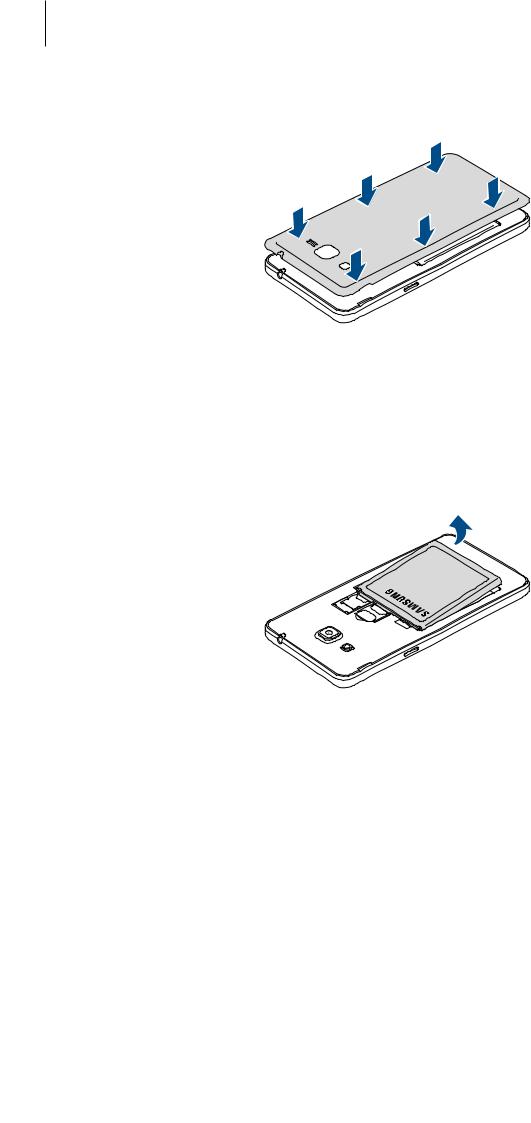
Basics
3 Replace the back cover.
Removing the battery
1
2
Remove the back cover.
Pull out the battery.
9
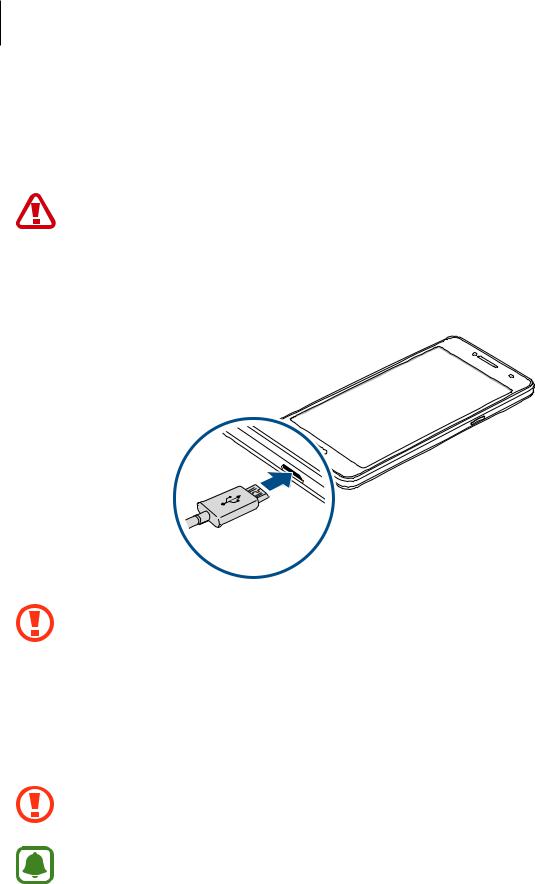
Basics
Charging the battery
Charge the battery before using it for the first time or when it has been unused for extended periods.
Use only Samsung-approved chargers, batteries, and cables. Unapproved chargers or cables can cause the battery to explode or damage the device.
1 Connect the USB cable to the USB power adaptor, and then plug the end of the USB cable into the multipurpose jack.
2
3
Connecting the charger improperly may cause serious damage to the device. Any damage caused by misuse is not covered by the warranty.
Plug the USB power adaptor into an electric socket.
After fully charging, disconnect the device from the charger. First unplug the charger from the device, and then unplug it from the electric socket.
Do not remove the battery before removing the charger. This may damage the device.
To save energy, unplug the charger when not in use. The charger does not have a power switch, so you must unplug the charger from the electric socket when not in use to avoid wasting power. The charger should remain close to the electric socket and easily accessible while charging.
10

Basics
Viewing the remaining charging time
While charging, open the Home screen and tap Apps →Settings →Device maintenance → Battery.
The actual charging time may vary depending on the status of your device and the charging conditions. The remaining charging time may not be displayed when you charge the device in very cold or very hot conditions.
Reducing the battery consumption
Your device provides various options that help you conserve battery power.
•Optimise the device using the device maintenance feature.
•When you are not using the device, switch to sleep mode by pressing the Power key.
•Activate power saving mode.
•Close unnecessary apps.
•Deactivate the Bluetooth feature when not in use.
•Deactivate the Wi-Fi feature when not in use.
•Deactivate auto-syncing of apps that need to be synced, such as emails.
•Decrease the backlight time.
•Decrease the screen brightness.
Battery charging tips and precautions
•When the battery power is low, the battery icon appears empty.
•If the battery is completely discharged, the device cannot be turned on immediately when the charger is connected. Allow a depleted battery to charge for a few minutes before turning on the device.
•If you use multiple apps at once, network apps, or apps that need a connection to another device, the battery will drain quickly. To avoid losing power during a data transfer, always use these apps after fully charging the battery.
•Using a power source other than the charger, such as a computer, may result in a slower charging speed due to a lower electric current.
•The device can be used while it is charging, but it may take longer to fully charge the battery.
•If the device receives an unstable power supply while charging, the touchscreen may not function. If this happens, unplug the charger from the device.
11

Basics
•While charging, the device and the charger may heat up. This is normal and should not affect the device’s lifespan or performance. If the battery gets hotter than usual, the charger may stop charging.
•If you charge the device while the multipurpose jack is wet, the device may be damaged. Thoroughly dry the multipurpose jack before charging the device.
•If the device is not charging properly, take the device and the charger to a Samsung Service Centre.
Power saving mode
Activate power saving mode to extend the battery’s usage time.
1
2
On the Home screen, tap Apps →Settings →Device maintenance →Battery →MID.
Tap CUSTOMISE to change the power saving settings before entering power saving mode.
3 Tap APPLY.
Maximum power saving mode
In maximum power saving mode, the device decreases battery consumption by applying the dark theme and limiting the apps and features available. Network connections, except for the mobile network, will be deactivated.
1
2
On the Home screen, tap Apps →Settings →Device maintenance →Battery →MAX.
Tap CUSTOMISE to change the power saving settings before entering maximum power saving mode.
3 Tap APPLY.
After entering maximum power saving mode, on the Home screen, tap  and select an app to use. To remove apps, tap
and select an app to use. To remove apps, tap  →Edit and select an app with
→Edit and select an app with  .
.
To deactivate maximum power saving mode, tap  →Disable Maximum power saving mode.
→Disable Maximum power saving mode.
The estimated battery usage time may vary depending on your device settings and operating conditions.
12

Basics
SIM or USIM card
Installing the SIM or USIM card
Insert the SIM or USIM card provided by the mobile telephone service provider.
|
• |
Use only a microSIM card. |
|
• |
Use caution not to lose or let others use the SIM or USIM card. Samsung is not |
|
||
|
||
|
|
responsible for any damages or inconveniences caused by lost or stolen cards. |
1
2
•Dual SIM models: In some areas, data transfer speeds may be slower if two SIM cards are inserted in the device than when one SIM card is inserted.
•Some LTE services may not be available depending on the service provider. For more information about service availability, contact your service provider.
Remove the back cover and battery.
►Single SIM models: Insert the SIM or USIM card with the gold-coloured contacts facing downwards.
13
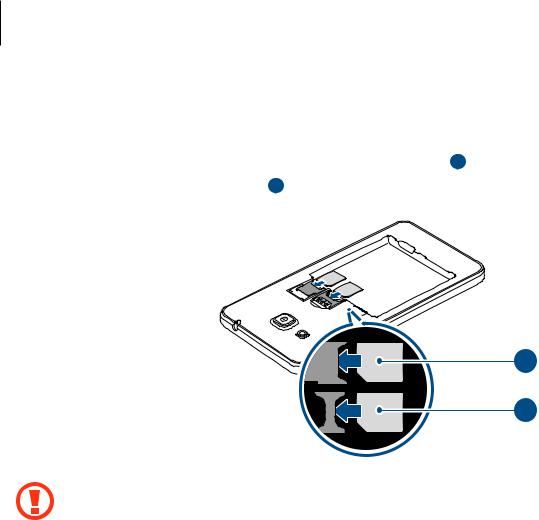
Basics
►Dual SIM models: Insert the SIM or USIM card with the gold-coloured contacts facing downwards.
Insert the primary SIM or USIM card into SIM card slot 1 ( 1 ) and the secondary SIM or USIM card into SIM card slot 2 ( 2 ).
1 |
2 |
Do not insert a memory card into the SIM card slot. If a memory card happens to be lodged in the SIM card slot, take the device to a Samsung Service Centre to remove the memory card.
3 Replace the battery and back cover.
14

Basics
Removing the SIM or USIM card
1
2
Remove the back cover and battery.
Pull out the SIM or USIM card.
►Single SIM models:
►Dual SIM models:
15

Basics
Using dual SIM or USIM cards (dual SIM models)
If you insert two SIM or USIM cards, you can have two phone numbers or service providers for a single device.
Activating SIM or USIM cards
On the Home screen, tap Apps →Settings →Connections →SIM card manager. Select a SIM or USIM card and tap the switch to activate it.
Customising SIM or USIM cards
On the Home screen, tap Apps →Settings →Connections →SIM card manager and select a SIM or USIM card to access the following options:
•Icon: Change the icon of the SIM or USIM card.
•Name: Change the display name of the SIM or USIM card.
•Network mode: Select a network type to use with the SIM or USIM card.
Setting preferred SIM or USIM cards
When two cards are activated, you can assign voice calls, messaging, and data services to specific cards.
On the Home screen, tap Apps →Settings →Connections →SIM card manager and set the feature preferences for your cards in Preferred SIM card.
16
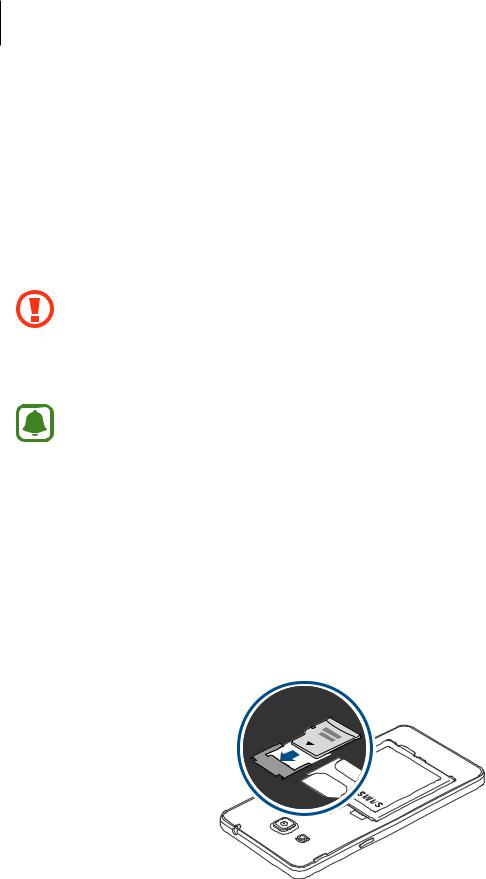
Basics
Memory card (microSD card)
Installing a memory card
Your device’s memory card capacity may vary from other models and some memory cards may not be compatible with your device depending on the memory card manufacturer and type. To view your device’s maximum memory card capacity, refer to the Samsung website.
1
2
• |
Some memory cards may not be fully compatible with the device. Using an |
|
incompatible card may damage the device or the memory card, or corrupt the data |
|
stored in it. |
• |
Use caution to insert the memory card right-side up. |
• |
The device supports the FAT and the exFAT file systems for memory cards. When |
|
inserting a card formatted in a different file system, the device asks to reformat the |
|
memory card. |
•Frequent writing and erasing of data shortens the lifespan of memory cards.
•When inserting a memory card into the device, the memory card’s file directory appears in the My Files →SD card folder.
Remove the back cover.
Insert a memory card with the gold-coloured contacts facing downwards.
3 Replace the back cover.
17

Basics
Removing the memory card
Before removing the memory card, first unmount it for safe removal.
On the Home screen, tap Apps →Settings →Device maintenance →Storage → → Storage settings →SD card →Unmount.
→ Storage settings →SD card →Unmount.
1
2
3
Remove the back cover.
Pull out the memory card.
Replace the back cover.
Do not remove the memory card while the device is transferring or accessing information. Doing so can cause data to be lost or corrupted or damage to the memory card or device. Samsung is not responsible for losses that result from the misuse of damaged memory cards, including the loss of data.
Formatting the memory card
A memory card formatted on a computer may not be compatible with the device. Format the memory card on the device.
On the Home screen, tap Apps →Settings →Device maintenance →Storage → → Storage settings →SD card →Format →FORMAT.
→ Storage settings →SD card →Format →FORMAT.
Before formatting the memory card, remember to make backup copies of all important data stored in the memory card. The manufacturer’s warranty does not cover loss of data resulting from user actions.
Turning the device on and off
Press and hold the Power key for a few seconds to turn on the device.
When you turn on your device for the first time or after performing a data reset, follow the onscreen instructions to set up your device.
To turn off the device, press and hold the Power key, and then tap Power off.
• If your device is frozen and unresponsive, press and hold the Power key and the
Volume Down key simultaneously for more than 7 seconds to restart it.
•Follow all posted warnings and directions from authorised personnel in areas where the use of wireless devices is restricted, such as aeroplanes and hospitals.
18

Basics
Touchscreen
• Do not allow the touchscreen to come into contact with other electrical devices. Electrostatic discharges can cause the touchscreen to malfunction.
•To avoid damaging the touchscreen, do not tap it with anything sharp or apply excessive pressure to it with your fingertips.
•The device may not recognise touch inputs close to the edges of the screen, which
are outside of the touch input area.
•Leaving the touchscreen idle for extended periods may result in afterimages (screen burn-in) or ghosting. Turn off the touchscreen when you do not use the device.
•It is recommended to use fingers when you use the touchscreen.
Tapping
To open an app, to select a menu item, to press an on-screen button, or to enter a character using the keyboard on the screen, tap it with your finger.
Tapping and holding
Tap and hold an item or the screen for more than 2 seconds to access available options.
19

Basics
Dragging
To move an item, tap and hold it and drag it to the target position.
Double-tapping
Double-tap on a webpage or image to zoom in. Double-tap again to return.
Swiping
Swipe to the left or right on the Home screen or the Apps screen to view other panels. Swipe upwards or downwards to scroll through a webpage or a list of items, such as contacts.
20

Basics
Spreading and pinching
Spread two fingers apart on a webpage, map, or image to zoom in a part. Pinch to zoom out.
Home screen
Home screen
The Home screen is the starting point for accessing all of the device’s features. It displays widgets, shortcuts to apps, and more.
To view other panels, swipe to the left or right, or tap one of the screen indicators at the bottom of the screen.
A widget |
|
|
|
|
|
|
|
|
|
|
|
|
|
|
|
|
|
|
|
|
|
|
|
|
|
||
|
|
|
|
|
|
|
|
|
|
|
|
||
An app |
|
|
|
|
|
|
|
|
|
|
|
|
A folder |
|
|
|
|
|
|
|
|
|
|
|
|
||
|
|
|
|
|
|
|
|
|
|
|
|
||
Favourite apps |
|
|
|
|
|
|
|
|
|
|
|
|
Screen indicators |
|
|
|
|
|
|
|
|
|
|
||||
|
|
|
|
|
|
|
|
|
|
|
|||
|
|
|
|
|
|
|
|
|
|
|
|
Apps screen icon |
|
|
|
|
|
|
|
|
|
|
|
|
|
||
|
|
|
|
|
|
|
|
|
|
|
|||
|
|
|
|
|
|
|
|
|
|
|
|
|
|
|
|
|
|
|
|
|
|
|
|
|
|
|
|
21
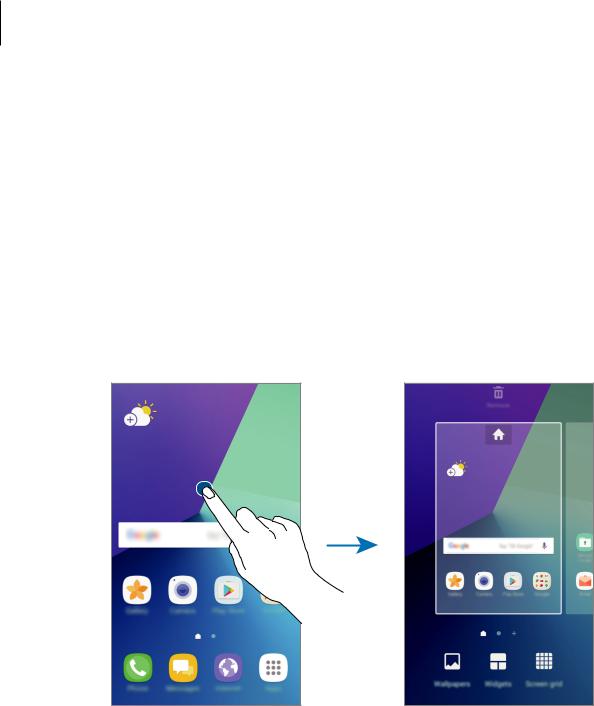
Basics
Home screen options
On the Home screen, tap and hold an empty area, or pinch your fingers together to access the available options. Customise the Home screen by adding, deleting, or rearranging Home screen panels. You can also set the Home screen wallpaper, add widgets to the Home screen, and more.
•Wallpapers: Change the wallpaper settings for the Home screen and the locked screen.
•Widgets: Add widgets to the Home screen. Widgets are small apps that launch specific app functions to provide information and convenient access on your Home screen.
•Screen grid: Change the size of the grid to display more or less items on the Home screen and the Apps screen.
Adding items
Tap and hold an app or a folder from the Apps screen, and then drag it to the Home screen.
To add widgets, tap and hold an empty area on the Home screen, tap Widgets, tap and hold a widget, and then drag it to the Home screen.
22

Basics
Moving items
Tap and hold an item on the Home screen, and then drag it to a new location.
You can also move frequently used apps to the shortcuts area at the bottom of the Home screen.
To move the item to another panel, drag it to the side of the screen.
To move an item more easily, tap and hold an item, and drag it to Move apps at the top of the screen. The item will move to the panel at the top of the screen. Swipe to the left or right to move to another panel and drag the item to a new location.
Removing items
Tap and hold an item, and then drag it to Remove at the top of the screen.
Creating folders
Create folders and gather similar applications to quickly access and launch apps.
1
2
On the Home screen, tap and hold an app, and then drag it over another app.
Drop the app when a folder frame appears around the apps. A new folder containing the selected apps will be created.
23

Basics
3 Tap Enter folder name and enter a folder name. To change the folder colour, tap  .
.
To add more apps to the folder, tap ADD, tick the apps, and then tap ADD. You can also add an app by dragging it to the folder on the Home screen.
To move apps from a folder to the Home screen, tap the folder, and then drag an app to the Home screen.
To delete apps in a folder, tap the folder, and then drag the app you want to delete to Remove at the top of the screen.
Managing panels
On the Home screen, tap and hold an empty area to add, move, or remove a panel. To add a panel, swipe to the left, and then tap  .
.
To move a panel, tap and hold a panel preview, and then drag it to a new location.
To remove a panel, tap and hold a panel preview, and then drag it to Remove at the top of the screen.
To set a panel as the main Home screen, tap  .
.
Apps screen
The Apps screen displays icons for all apps, including newly installed apps.
On the Home screen, tap Apps to open the Apps screen. To view other panels, swipe to the left or right, or select a screen indicator at the bottom of the screen.
Moving items
This feature may not be available depending on the region or service provider.
On the Apps screen, tap  →Edit. Tap and hold an item and drag it to a new location. To move the item to another panel, drag it to the side of the screen.
→Edit. Tap and hold an item and drag it to a new location. To move the item to another panel, drag it to the side of the screen.
24
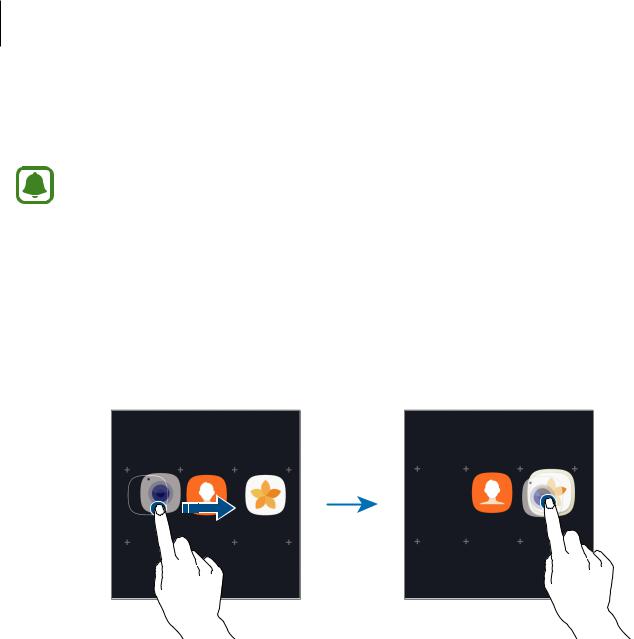
Basics
Creating folders
Create folders and gather similar applications to quickly access and launch apps you want.
This feature may not be available depending on the region or service provider.
1
2
3
4
On the Apps screen, tap  →Edit.
→Edit.
Tap and hold an app, and then drag it over another app.
Drop the app when a folder frame appears around the apps.
A new folder containing the selected apps will be created.
Tap Enter folder name and enter a folder name. To change the folder colour, tap  .
.
To add more apps to the folder, tap ADD, tick the apps, and then tap ADD. You can also add an app by dragging it to the folder on the Apps screen.
To delete a folder, select a folder with  . Only the folder will be deleted. The folder’s apps will be relocated to the Apps screen.
. Only the folder will be deleted. The folder’s apps will be relocated to the Apps screen.
Rearranging items
You can rearrange items in alphabetical order on the Apps screen.
On the Apps screen, tap  →Sort →Alphabetical order.
→Sort →Alphabetical order.
25

Basics
Searching for items
You can search for items on the Apps screen.
On the Apps screen, enter characters in the search field. The device will search for and display the items containing the characters you entered.
Indicator icons
Indicator icons appear on the status bar at the top of the screen. The icons listed in the table below are most common.
The status bar may not appear at the top of the screen in some apps. To display the status bar, drag down from the top of the screen.
Icon |
Meaning |
|
No signal |
|
|
/ |
Signal strength |
|
|
/ |
Currently accessing SIM or USIM card (dual SIM models) |
|
|
/ |
Roaming (outside of normal service area) |
|
|
|
GPRS network connected |
|
|
|
EDGE network connected |
|
|
|
UMTS network connected |
|
|
|
HSDPA network connected |
|
|
|
HSPA+ network connected |
|
|
/ |
LTE network connected |
|
|
|
Wi-Fi connected |
|
|
|
Bluetooth feature activated |
|
|
|
GPS activated |
|
|
|
Call in progress |
|
|
|
Missed call |
|
|
|
New text or multimedia message |
|
|
|
Alarm activated |
|
|
|
Mute mode activated |
|
|
|
Vibration mode activated |
|
|
|
Flight mode activated |
|
|
26

Basics
Icon Meaning
Error occurred or caution required
Battery power level
Lock screen
Pressing the Power key turns off the screen and locks it. Also, the screen turns off and automatically locks if the device is not used for a specified period.
The screen is locked with Swipe, the default screen lock method.
Press the Power key or the Home key and swipe in any direction to unlock the screen.
To change the screen lock method, on the Apps screen, tap Settings →Lock screen and security →Screen lock type, and then select a method.
When you set a pattern, PIN, or password for the screen lock method, you can protect your personal information by preventing others from accessing your device. After setting the screen lock method, the device will require an unlock code whenever unlocking it.
•Swipe: Swipe in any direction on the screen to unlock it.
•Pattern: Draw a pattern with four or more dots to unlock the screen.
•PIN: Enter a PIN with at least four numbers to unlock the screen.
•Password: Enter a password with at least four characters, numbers, or symbols to unlock the screen.
•None: Do not set a screen lock method.
27

Basics
• If the unlock code is forgotten, take the device to a Samsung Service Centre to reset it.
•You can set your device to perform a factory data reset if you enter the unlock code incorrectly several times in a row and reach the attempt limit. On the Apps screen, tap Settings →Lock screen and security →Secure lock settings and tap the
Auto factory reset switch to activate it.
Notification panel
Using the notification panel
When you receive new notifications, such as messages or missed calls, indicator icons appear on the status bar. To see more information about the icons, open the notification panel and view the details.
To open the notification panel, drag the status bar downwards. To close the notification panel, swipe upwards on the screen.
You can use the following functions on the notification panel.
28
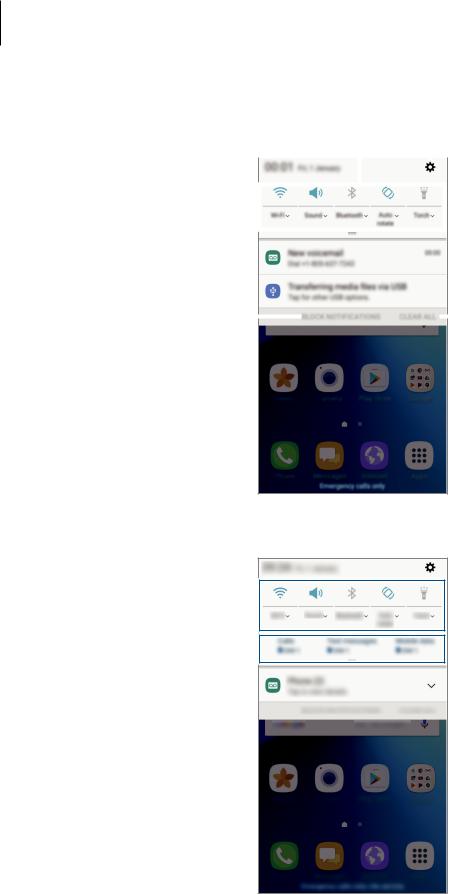
Basics
►Single SIM models:
Quick setting buttons |
|
|
|
|
|
|
Launch Settings. |
|
|
|
|
|
|
||
|
|
|
|
|
|
|
|
|
|
|
|
|
|
|
|
Tap a notification and perform  various actions.
various actions.
Block notifications from apps. |
|
|
|
Clear all notifications. |
|
|
►Dual SIM models:
Quick setting buttons 
Tap a notification and perform  various actions.
various actions.
Block notifications from apps. 
 Launch Settings.
Launch Settings.
 SIM and USIM card feature preferences. Tap to access the SIM card manager.
SIM and USIM card feature preferences. Tap to access the SIM card manager.
 Clear all notifications.
Clear all notifications.
29
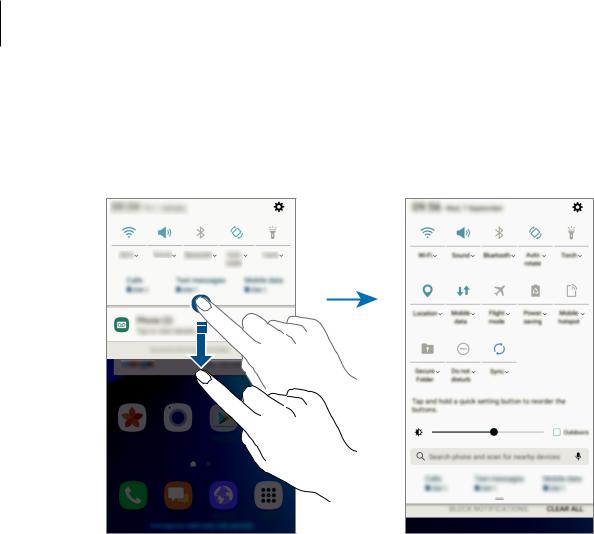
Basics
Using quick setting buttons
Tap quick setting buttons to activate some features. Swipe downwards on the notification panel to view more buttons.
To view more detailed settings, tap the text under each button.
To rearrange buttons, tap and hold a quick setting button until all the quick setting buttons are displayed. Then, tap and hold a button, and then drag it to another location.
Finder
Search for a variety of content with a keyword or search for nearby devices.
Searching for content or nearby devices
Open the notification panel, swipe downwards on the notification panel, and then tap Search device.
Enter a keyword in the search field or tap  and say a keyword.
and say a keyword.
To get more refined results, tap Filter under the search field, and then select filter details.
Setting search categories
You can set search categories to search for content in specific search fields. Tap  →Settings →Select search locations and select categories.
→Settings →Select search locations and select categories.
30
